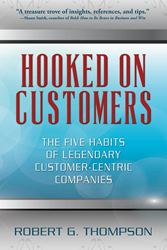Leading any organization is difficult. For many, the operational components are easy and dealing with the “people part” is where their challenges emerge. But for others, the soft-skills people-part is easier and the nuts-and-bolts part of the business cause the pains.
When it comes to the operational nuts-and-bolts part of leading a business, there are some great ways to lead with better results.
And this is how you deal with using business information, big data, and analytics strategically to lead through better results.
In his book “Hooked on Customers: The Five Habits of Legendary Customer-Centric Companies,” author Bob Thompson spells out the strategic approach to help with the operational side of leading success.
Below are some of his thoughts and examples.
Using Analytics to Improve the Consumer Experience
 Business leaders are turning to analytics to uncover insights in so-called big data. However, big data is like a vein of gold buried under your feet. Unless you can mine it effectively to improve business performance, all that data could be a worthless distraction.
Business leaders are turning to analytics to uncover insights in so-called big data. However, big data is like a vein of gold buried under your feet. Unless you can mine it effectively to improve business performance, all that data could be a worthless distraction.
Analytics is a terms applied broadly, perhaps too broadly. The most common form is descriptive analytics used to slice and dice data to understand what happened in the past. But increasingly attention is turning to forward-looking analytics, using specialized algorithms and software.
Prescriptive analytics take it a step further and attempt to actually influence the future. For example, analytics can be used to help a call center agent decide the best offer to present to a customer to increase the odds of making a sale, or to suggest actions to deal with a service issue.
Macy’s is a great example of a major retailer competing for the loyalty of “omnichannel” shoppers—those using multiple channels, such as retail stores, websites, mobile devices, and even social media. Several years ago, the company began a customer-centric shift, led by Julie Bernard, group VP of customer centricity.
Speaking at a 2012 conference, Bernard said her goal was to “put the customer at the center of all decisions.” Sounds good, but old habits die hard in a 150-year-old brand where data was organized around products. The retailer used POS data to analyze product sales but couldn’t figure out what individual consumers were doing. One simple example: Did a spike in sales of a new pair of jeans mean the product was a hit or that one person bought all twelve pairs in a store?
By also looking at data from loyalty programs, credit cards, and other sources, Macy’s was able create a more complete understanding of the products, pricing, and experiences that move “loyals”—those consumers already buying regularly.
Another Example
Let’s look at another example in the world of e-commerce. Let’s say you want to present shoppers with hotel options in a major metropolitan area like New York. According to then Expedia VP Joe Megibow, most users won’t do a complex search of hundreds of hotels, so it’s critical that Expedia put the “best” options at the top of the list. If your instincts told you to present the cheapest or more popular hotels first, Expedia would frustrate a lot of shoppers and lose bookings.
Analytics determined the factors most likely to meet customer demand, such as real-time availability, inventory by class, rate deals, reviews, and purchase frequency. Then, using technology from an analytics software vendor, Expedia built a predictive analytics model based on the handful of factors that really mattered, out of about two dozen possibilities. The model was operationalized using Expedia’s own proprietary technology.
Result: When consumers search NY hotels, they’re more likely to find the hotels that they really want, and Expedia will get the sale. A great example of technology enabling a win-win.
**********
Never miss an issue of Linked 2 Leadership, subscribe today here.
Learn, Grow & Develop Other Leaders™
———————

Bob Thompson is Founder/CEO of CustomerThink
He is also and Author of the book “Hooked on Customers”
Email | LinkedIn | Twitter | Book | Web | Blog
Image Sources: media-cache-ec0.pinimg.com


Reblogged this on Mr Business Info Blog – UK Business Financial Information & Credit Industry News, Products & Services.
Reblogged this on THE STRATEGIC LEARNER.